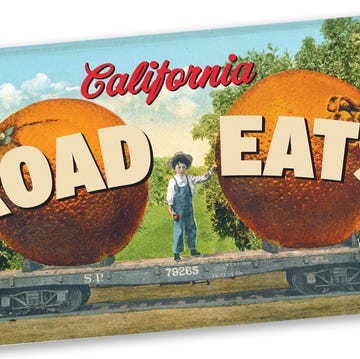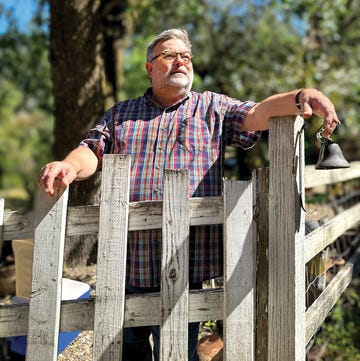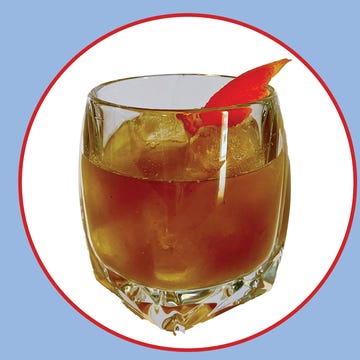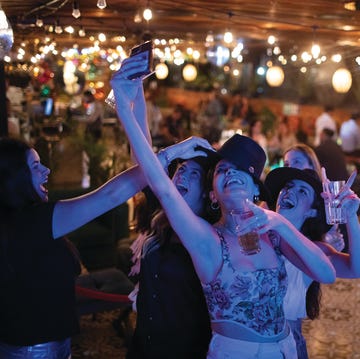Southern California didn’t invent the hamburger. That honor might go to Charlie Nagreen of Wisconsin, who squished a meatball between two slices of bread, or to Oklahoman Oscar Weber Bilby, who did much the same thing with a ground-beef patty and a homemade bun. But does it matter who invented the burger, or where? What Southern California accomplished was, in many ways, more miraculous: As the birthplace of some of the nation’s biggest burger chains, the region exported the humble sandwich to the American masses and, in time, the world.
Consider the Big Mac. Should you find yourself far from home and jonesing for one, you might be in luck, since there are more than 41,000 McDonald’s worldwide, from South Africa to Samoa. So many humans have eaten “two all-beef patties, special sauce, lettuce, cheese, pickles, onions, and a sesame seed bun” that, in the early ’90s, the company replaced its ongoing roadside tally—“We have sold over 1 million,” one early sign crowed—with the perennial slogan “Billions and billions served.”
This article appears in Issue 30 of Alta Journal.
SUBSCRIBE
The first McDonald’s (founded by brothers Maurice and Richard McDonald—not Ray Kroc) opened in San Bernardino in 1940, right off Route 66. The restaurant rushed its food to hungry travelers via the kitchen’s groundbreaking Speedee Service System, which mirrored an auto assembly line. The brothers soon had local competition in the fight for fast-food-burger supremacy: Eight years later, the first In-N-Out Burger popped up in Los Angeles’s Baldwin Park, featuring the state’s premier burger-stand drive-through window. In 1951, the inaugural Jack in the Box debuted in San Diego; soon, customers across the state were placing orders by talking into a clown’s head. Other California chains contributing to the boom included A&W, which launched in Lodi, and Carl’s Jr., which took things up a notch in 1956 by charbroiling patties at its first two restaurants in Anaheim and Brea.
Why did burger places multiply in California when similar burger joints didn’t in other states? There was the speed of preparation and delivery, which made burgers ideal for the state’s emerging on-the-go car culture—they’re a lot easier to eat behind a steering wheel than, say, a hot dog or a taco. McDonald’s made fast food fun, too, by adding slides, tube mazes, and ball pits to franchises and serving Happy Meals with limited-edition doodads. Mascots were clowns (McDonald’s, Jack in the Box), anthropomorphized stars (Carl’s Jr.), and even a bipedal, sweater-wearing bear (A&W). And the cookie-cutter aspect of chains offered a familiarity and reliability to travelers that hastened the restaurants’ expansion outside of California.
Somewhere along the way, fast-food burgers became a symbol of America—and something of our national dish. Outside of a few national holidays, when was the last time you ordered a hot dog or a slice of apple pie? Burgers, meanwhile, are the food of the American masses, consumed by diners of every class and creed. If you’re a big shot and want to signal that you’re just like us, after you pick up a Golden Globe or an Oscar, you pick up an In-N-Out Double-Double with a chocolate shake and Instagram about it.
Not surprisingly, fast-food burgers, with their high fat, sodium, and calorie counts, also became a symbol of much that is wrong about the way America eats. Environmental activists point at the impact the production of billions of burgers has on greenhouse gas emissions and the climate crisis (to say nothing of the suboptimal life of cows that become patties). McDonald’s is shorthand for the worst aspects of our consumerism—large, mass-produced homes in suburbia are dubbed McMansions, while poorly paid gigs are McJobs.
And then there’s the food itself. In the 2004 documentary Super Size Me, the late director Morgan Spurlock ate nothing but McDonald’s for 30 days. By the third week, he was experiencing heart palpitations and had sustained liver damage; by the end of the experiment, he had gained 25 pounds, most of it fat. Super Size me, indeed.
And yet we still love these burgers, wherever we may find them. On a recent trip to Tokyo, I went to a McDonald’s in Asakusa. My son ordered the Teriyaki McBurger Set—your typical McDonald’s burger combo meal, but with the patty dunked in teriyaki sauce. Other than the sauce and the soda size (Japan’s large is roughly an American medium), everything about the experience was identical to what you would get in the States. Which is, of course, the point. It’s a taste of home. And for the Japanese, whose first McDonald’s opened in 1971 in Tokyo’s fashionable Ginza district, it’s become a taste of home too.
But the fast-food burger will always belong to Southern California. You can make a pilgrimage to the San Bernardino site of the first McDonald’s (no restaurant, but a cool museum) or to Downey, home to the oldest McDonald’s in operation. The original In-N-Out in Baldwin Park was demolished to make way for the 10 freeway, but you can still visit a nonfunctioning but faithful replica nearby, complete with vintage signage and a classic cigarette machine. Or you can drive to the present-day A&W in Lodi, not far from the original, and peruse the memorabilia-filled display cases.
Even if you’re not at one of the original sites, that Quarter Pounder with Cheese or Jumbo Jack Cheeseburger will have the same patty and “special sauce” and gooey American cheese no matter where you consume it. It’ll be the same burger you scarfed down when you were 8 or 18 and, given the well-earned longevity of these places, the same one you’ll eat when you’re 80.•
Robert Ito is a journalist based in Los Angeles. He writes about film, television, and theater for the New York Times.














